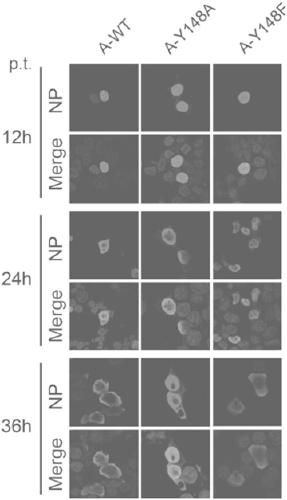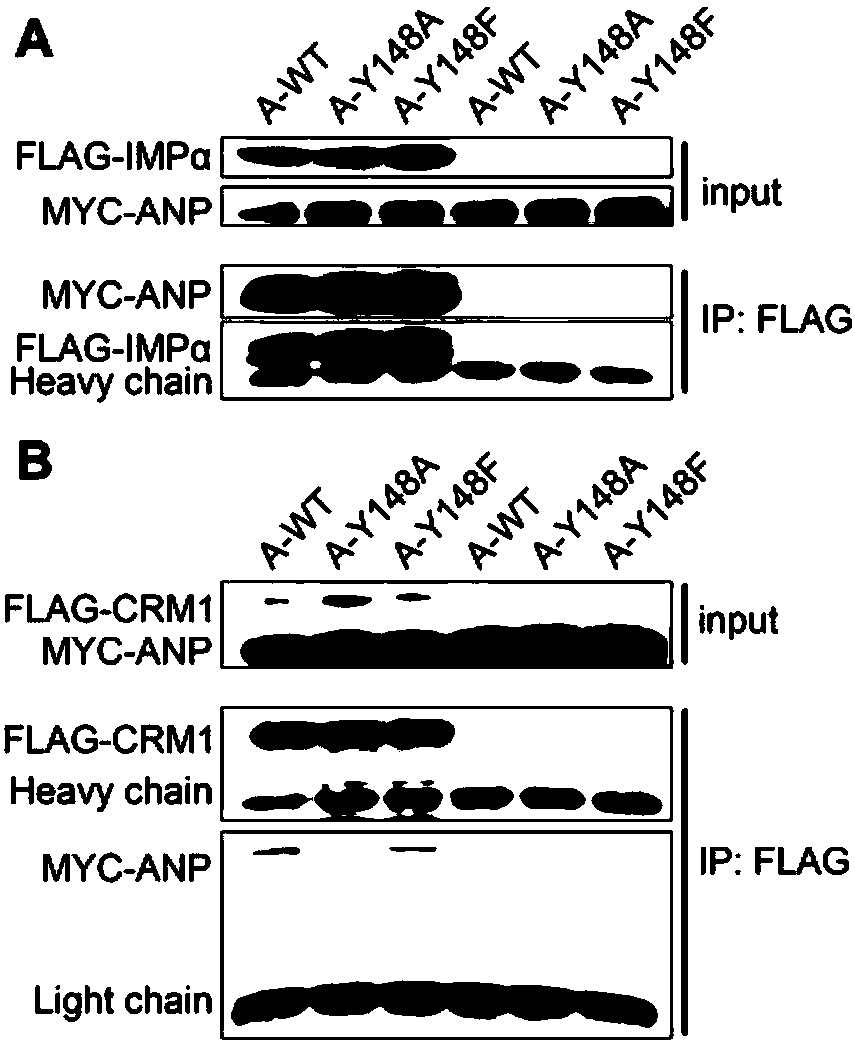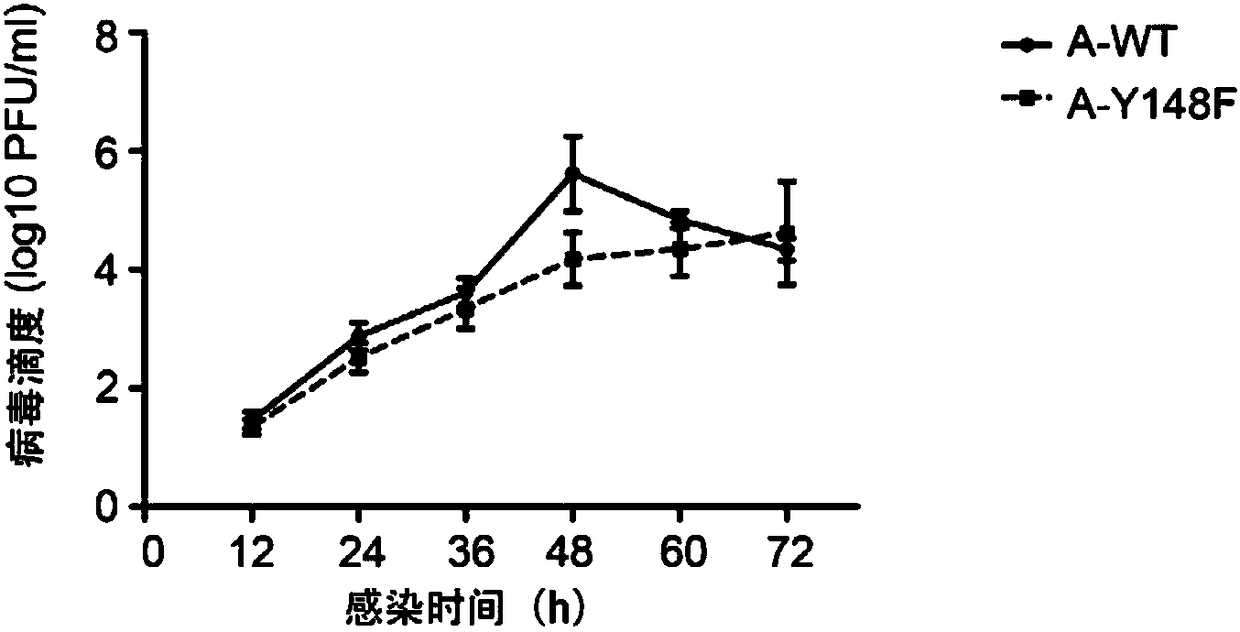Key amino acid locus for regulating and controlling A type and B type influenza virus nucleoprotein to export nuclear and application thereof in anti-influenza virus drug target spot
An influenza virus infection and influenza virus technology, applied in the field of biomedicine, can solve the problem of unclear key sites of NP entry/exit of influenza A virus.
- Summary
- Abstract
- Description
- Claims
- Application Information
AI Technical Summary
Problems solved by technology
Method used
Image
Examples
Embodiment 1A
[0097] Example 1 Influenza virus nucleoprotein Y148 residues affect ANP out of nucleus
[0098] 1. Vector construction
[0099] Construction of wild-type influenza A virus nucleoprotein (ANP) and its Y148 residue mutant:
[0100] The wild-type ANP has the amino acid sequence shown in NCBI No. ACF54602.1; the A-Y148A and A-Y148F mutant fragments are sequences in which the 148th amino acid of the wild-type ANP sequence is mutated to alanine and phenylalanine, respectively.
[0101] The above wild-type ANPs were cloned into pcDNA4TO (Invitrigen, catalog number V103020), pCMV-MYC (Clontech, catalog number 635689) and expression vector pHH21 (from the gift of Professor Yoshihiro Kawaoka, University of Wisconsin-Madison, USA). The vector is described in "Neumann G, et al., Generation of influenza A viruses entirely from cloned cDNAs, Proc Natl Acad Sci US A. 1999; 96(16): 9345-50"). pHH21 and pcDNA4TO belong to the influenza virus reverse genetic packaging system. The pHH21 vector has a pr...
Embodiment 2
[0114] Example 2 Type A influenza virus nucleoprotein Y148 residue affects type A influenza virus replication and virulence
[0115] 1. Rescue of recombinant influenza A virus containing A-Y148 mutation
[0116] Using Neumann G, Watanabe T, Ito H, Watanabe S, Goto H, Gao P, Hughes M, PerezDR, Donis R, Hoffmann E, Hobom G, Kawaoka Y., Generation of influenza A viruses entirely from cloned cDNAs, Proc Natl Acad Sci US A.1999,96(16): 9345-50, replace the NP-containing related vector with the A-ANP wild-type fragment, A-Y148A mutant fragment or A-Y148F prepared in Example 1 The pHH21 vector of the mutant fragment implements the rescue of the recombinant influenza A virus. Utilize Lipofectamine TM 2000 transfection. After 6 hours of transfection, the medium was changed, 2 μg / ml serum-free DMEM containing TPCK-treated pancreatin (SIGMA, article number T1426) was added, and the supernatant was harvested after 72h-96h of culture.
[0117] Two, plaque test to detect virus titer
[0118] C...
Embodiment 3B
[0137] Example 3 Influenza B virus nucleoprotein F209 residues affect the nucleation of influenza B virus nucleoprotein
[0138] 1. Research on key sites of influenza B virus nucleoprotein (BNP)
[0139] The structure of BNP and ANP are very similar. In particular, both contain an RNA binding groove rich in basic amino acids (Ye Q, Krug RM, Tao YJ., The mechanism by which influenza A virus nucleoproteinforms oligomers and binds RNA, Nature. 2006; 444(7122): 1078-82. Ng AK, Lam MK, Zhang H, Liu J, Au SW, Chan PK, etc., Structural basis for RNA binding and homo-oligomer formation by influenza B virus nucleoprotein, Journal of virology. 2012; 86(12): 6758 -67). The sequence alignment results showed that there is an aromatic amino acid in the RNA binding groove of ANP and BNP, Y148 of ANP and F209 of BNP ( Figure 5 A), and the sequence homology near these two sites is very high ( Figure 5 B). Therefore, we speculate that B-F209 may also play a similar function to A-Y148 during the...
PUM
 Login to View More
Login to View More Abstract
Description
Claims
Application Information
 Login to View More
Login to View More - R&D
- Intellectual Property
- Life Sciences
- Materials
- Tech Scout
- Unparalleled Data Quality
- Higher Quality Content
- 60% Fewer Hallucinations
Browse by: Latest US Patents, China's latest patents, Technical Efficacy Thesaurus, Application Domain, Technology Topic, Popular Technical Reports.
© 2025 PatSnap. All rights reserved.Legal|Privacy policy|Modern Slavery Act Transparency Statement|Sitemap|About US| Contact US: help@patsnap.com



